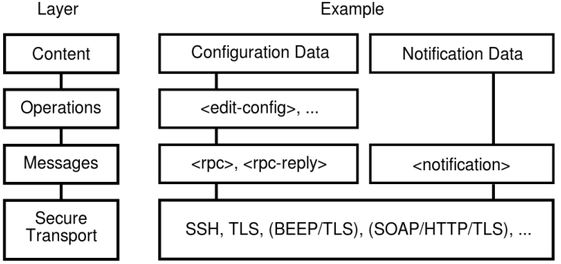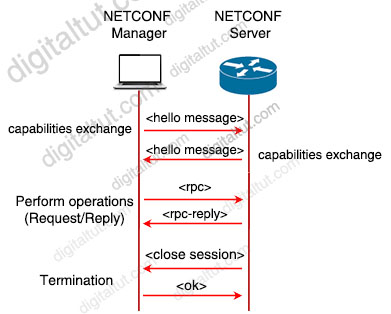NETCONF tutorial
Network Configuration Protocol (NETCONF), like the traditional CLI mode and SNMP, is a network device management protocol. It provides a mechanism for configuring devices and querying the network configuration and status. So why should we use NETCONF instead of CLI? The main reason is: NETCONF is ideal for network automation and cloud-based networks.
The traditional CLI mode is designed to be used by humans and based on man-machine interfaces. The CLI provides humans with a very user-friendly means for interacting with a device. Commands are very readable, easy to remember and have no painful syntactic requirements. But the configuration varies with vendors. The same command is implemented in different ways on different devices and on different vendors. Therefore, the manual learning and maintaining cost is high.
Fortunately, the industry finally realized standardized data models and configuration protocols were needed. So, the IETF developed NETCONF and Yet Another Next Generation (YANG) data modeling language to add structure, interoperability, and control to the chaotic configuration environment.
|
What are Data Models? – Data models described constrained set of data Data Model Example How do you describe a VLAN? Maybe you think about VLAN ID, VLAN name or VLAN state. With data model, VLAN is defined like this: + VLAN ID – integer between 1 and 4096 This is defining the constraints of the data – the Data Model for a VLAN. |
NETCONF, on the other hand, was designed for automation applications. It uses a clearly defined XML API that computer programs can understand easily. Similar to SNMP that uses MIB files to model data, NETCONF uses YANG to describe the interaction models between the NETCONF client and server.
|
Note: Even though SNMP supports operations to configure devices, it is limited to collecting statistics and status information from network devices. It is hardly used for configuration purposes. |
By following YANG models, configuration engineers can use a graphical application to generate configurations for different devices of different vendors with ease. Engineers do not need to pay attention to the differences between YANG models as well. The graphical application automatically parses the YANG model data, shifting the focus of engineers from device and function differences to user requirements.
Another advantage of NETCONF is that it allows configuration to occur in a transactional manner (backup and restore capability). NETCONF takes into account when some of the network devices successfully upload the configuration, but others fail to upload the configuration. In this case, NETCONF allows a managed device to rollback to a known-state configuration. This is because NETCONF defines transactional models that synchronize, validate, and commit device configuration within an entire network deployment.
NETCONF can be conceptually partitioned into four layers:

– Layer 1: The transport protocol layer provides a communication path between the client and server. NETCONF can be layered over any transport protocol that provides a set of basic requirements.
– Layer 2: The Remote Procedure Calls (RPC) layer provides a simple, transport-independent framing mechanism for encoding RPCs. RPC is a kind of request-response protocol. An RPC is initiated by the client, which sends a request message to a known remote server to execute a specified procedure with supplied parameters. The remote server sends a response to the client, and the application continues its process. ALL NETCONF messages are encoded in XML.
– Layer 3: The operations layer defines a set of base operations invoked as RPC methods with XML-encoded parameters.
– Layer 4: The content layer did not provided a standard for content layer in the RFC. In 2008 and 2009 a NETMOD working group came up with YANG. YANG at the Content layer is used to provide the “human readable” format. YANG is a data modeling language used to model configuration and state data manipulated by NETCONF, NETCONF remote procedure calls, and NETCONF notifications.
How NETCONF works?
In below graphic, you can see that a NETCONF manager (usually our SSH client) communicates with a NETCONF server (usually the network device at hand). They exchange capabilities to understand what features are supported. Using Remote Procedure Call (RPC) calls, the SSH client can then retrieve information from the SSH server. The support of SSH is considered mandatory for NETCONF implementations.

NETCONF Transport
NETCONF messages are encoded in XML. Each message is framed by:
– NETCONF 1.0: a character sequence ]]>]]>
– NETCONF 1.1: a line with the number of characters to read in ASCII
– NETCONF messages are encrypted by SSH.
– NETCONF over SOAP, BEEP (both now deprecated) and TLS are also defined, but not used SSH provides authentication, integrity and confidentiality.
– NETCONF is connected oriented using TCP.
– No need for manager to request resends
– Efficient use of the medium
NETCONF Data stores
![]()
NETCONF utilizes multiple configuration data stores (candidate, running, startup) but “running” is the only mandatory data store. Each data store may hold an entire copy of the configuration. Not all data stores are supported by all devices. Not all device’s are writable -> May have to copy from writable one.
Note: Every NETCONF message must target a data store.
NETCONF Operations
NETCONF protocol is based on XML messages exchanged via SSH protocol using TCP port 830 (default). Network devices running a NETCONF agent can be managed through these operations:
| Operation | Description |
| <get> | Retrieve running configuration and device state information |
| <get-config> | Retrieve all or part of specified configuration datastore |
| <edit-config> | Loads all or part of a configuration to the specified configuration data store |
| <copy-config> | Replace an entire configuration data store with another |
| <delete-config> | Delete a configuration data store |
| <commit> | Copy candidate data store to running data store |
| <lock> / <unlock> | Lock or unlock the entire configuration data store system |
| <close-session> | Graceful termination of NETCONF session |
| <kill-session> | Forced termination of NETCONF session |
In the next page we will learn some examples of NETCONF operations.



last update dump ccnp date ?
Took exam in december, questions were up to date
hello everyone, would you please let me know where i can find the questions?
If I have understood it correctly, i assume that the Client in step 4 should traget the in the command instead of . Right?
„Candidate“ instead of „running“
Good Explanation ..